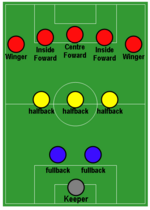|
The Metodo was devised by Vittorio Pozzo, coach of the Italian national team in the 1930s.[3] It was a derivation of the Danubian School. The system was based on the 2-3-5 formation, Pozzo realized that his halfbacks would need some more support in order to be superior to the opponents' midfield, so he pulled 2 of the forwards to just in-front of midfield, creating a 2-3-2-3 formation. This created a stronger defence than previous systems, as well as allowing effective counterattacks. The Italian national team won back-to-back World Cups in 1934 and 1938 using this system.
The WM
|
The WM system was created in the mid-1920s by Herbert Chapman of Arsenal to counter a change in the offside law in 1925. The change had reduced the number of opposition players that attackers needed between themselves and the goal-line from three to two. This led to the introduction of a centre-back to stop the opposing centre-forward, and tried to balance defensive and offensive playing. The formation became so successful that by the late-1930s most English clubs had adopted the WM. Retrospectively the WM has either been described as a 3-2-5 or as a 3-4-3.
|

WM Formation
|
The WW
The WW was a development of the WM created by the Hungarian coach Márton Bukovi who turned the 3-2-5 WM "upside down".[4] The lack of an effective centre-forward in his team necessitated moving this player back to midfield to create a playmaker, with a midfielder instructed to focus on defence. This created a 3-5-2 (also described as a 3-3-4), and was described by some as an early version of the 4-2-4. This formation was successfully used by fellow countryman Gusztáv Sebes in the Hungarian national team of the early 1950s.
3-3-4
The 3-3-4 formation was similar to the WW with the notable exception of having an inside-forward (as opposed to centre-forward) deployed as a midfield schemer alongside the two wing-halves. This formation would be commonplace during the 1950s and early 1960s. One of the best exponents of the system was the Tottenham Hotspur double-winning side of 1961, which deployed a midfield of Danny Blanchflower, John White and David Mackay. FC Porto won the 2005-06 Portuguese national championship using this unusual formation (coach: Co Adriaanse).
4-2-4

The 4-2-4 Formation
The 4-2-4 formation attempts to combine a strong attack with a strong defence, and was conceived as a reaction to WM's stiffness. It could also be considered a further development of the WW. The 4-2-4 was the first formation to be described using numbers.
While the initial developments leading to the 4-2-4 were devised by Márton Bukovi, the credit for creating the 4-2-4 lies with two different people: Flávio Costa, the Brazilian national coach in the early 1950s, as well as another Hungarian Béla Guttman. These tactics seemed to be developed independently, with the Brazilians discussing these ideas while the Hungarians seemed to be putting them into motion[5].[4][6] However the fully developed 4-2-4 was only 'perfected' in Brazil in the late 1950s.
Costa published his ideas, the "diagonal system", in the Brazilian newspaper O Cruzeiro, using schematics as the ones used here and, for the first time ever, the formation description by numbers as used in this article.[5] The "diagonal system" was another precursor of the 4-2-4 and was created to spur improvisation in players.
Guttman himself moved to Brazil later in the 1950s to help develop these tactical ideas using the experience of Hungarian coaches.
The 4-2-4 formation made use of the increasing players skills and fitness, aiming to effectively use 6 defenders and 6 forwards, with the midfielders performing both tasks. The 4th defender increased the number of defensive players but mostly allowed them to be closer together, thus enabling effective cooperation among them, the point being that a stronger defense would allow an even stronger attack.
The relatively empty midfield relied on defenders that should now be able not only to steal the ball, but also hold it, pass it or even run with it and start an attack. So this formation required that all players, including defenders, are somehow skillful and with initiative, making it a perfect fit for the Brazilian player's mind. The 4-2-4 needed a high level of tactical awareness as having only 2 midfielders could lead to defensive problems. The system was also fluid enough to allow the formation to change throughout play.
4-2-4 was first used with success at club level in Brazil by Palmeiras and Santos, and was used by Brazil in their wins at 1958 World Cup and 1970 World Cup, both featuring Pelé, and Zagallo who played in the first and coached the second. The formation was quickly adopted throughout the world after the Brazilian success.
Teams that used this formation
- Brazil, 1958 FIFA World Cup Winners:
- Team: Gilmar; Bellini, Djalma Santos, Nílton Santos, Orlando; Zito, Didi; Garrincha, Vává, Pelé, Zagallo. Coach: Vicente Feola.
- Celtic FC, European Cup 1966-67 Winners "The Lisbon Lions":
- Team: Ronnie Simpson; Jim Craig, Billy McNeill (captain), John Clark, Tommy Gemmell; Bobby Murdoch, Bertie Auld; Jimmy Johnstone, Willie Wallace, Stevie Chalmers, Bobby Lennox. Coach: Jock Stein.
- Brazil, 1970 FIFA World Cup winner:
- Team: Félix; Carlos Alberto, Brito, Piazza, Everaldo; Clodoaldo, Gérson; Jairzinho, Pelé, Tostão, Rivelino. Coach: Mário Zagallo.
Common modern formations
The following formations are used in modern football. The formations are flexible allowing tailoring to the needs of a team, as well as to the players available. Variations of any given formation include changes in positioning of players, as well as replacement of a traditional defender by a sweeper.
4-3-3
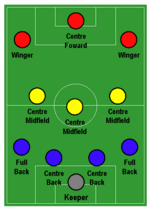
4-3-3 Formation
The 4-3-3 was a development of the 4-2-4, and was played by the Brazilian national team in the 1962 World Cup. Quite simply, it is a more attacking 4-5-1. The extra player in midfield allows a stronger defence, and the midfield could be staggered for different effects. The three midfielders normally play closely together to protect the defence, and move laterally across the field as a coordinated unit. The three forwards split across the field to spread the attack, and may be expected to tackle back. When used from the start of a game, this formation is widely regarded as encouraging defensive play, and should not be confused with the practice of modifying a 4-4-2 by bringing on an extra forward to replace a midfield player when behind in the latter stages of a game.
A staggered 4-3-3 involving a defensive midfielder (usually numbered 4 or 6) and two attacking midfielders (numbered 8 and 10) was commonplace in Italy, Argentina and Uruguay during the 1960s and 1970s. The Italian variety of 4-3-3 was simply a modification of WM, by converting one of the two wing-halves to a libero (sweeper), whereas the Argentine and Uruguayan formations were derived from 2-3-5 and retained the notional attacking centre-half. The national team which made this famous was the Dutch team of the 1974 and 1978 World Cups, even though the team won neither.
In club football, the team that brought this formation to the forefront was the famous Ajax Amsterdam team of the early 1970s, which won three European Cups with Johan Cruyff. Most teams using this formation now use the specialist defensive midfielder; Chelsea F.C. and F.C. Barcelona are the most famous recent examples.[7]
At the 2006 FIFA World Cup Spain and The Netherlands played both a variation of 4-3-3 without wingers. The three strikers would interchange positions and run the channels like a regular striker would.
Teams that used this formation
- Greece national football team, winners Euro 2004
- Brazil national team, winners 1962 FIFA World Cup
- Feyenoord in winning the 1970 European Cup
- Juventus F.C., Serie A Winners 1994/95 and UEFA Champions League Winners 1995/96
- Rosenborg BK of Norway, during all of their 13-in-a-row league wins, and 10 seasons in the UEFA Champions League
- All the teams coached by Zdeněk Zeman
- Chelsea F.C., Premiership Winners 2004/05 2005/06
- Olympique Lyonnais, Ligue 1 Winners 2001/02 2002/03 2003/04 2004/05 2005/06 2006/07
- FC Barcelona, La Liga Winners 2004/05 2005/06, UEFA Champions League 2005/06
- Chelsea F.C., UEFA Champions League 2007/2008 runner-up
- FC Zenit Saint Petersburg, UEFA Cup Winners 2007/08
|
4-4-2

4-4-2 Formation
This adaptable formation is the most common in football today, so well known that it has even inspired a magazine title, FourFourTwo. The midfielders are required to work hard to support both the defence and the attack: typically one of the central midfielders is expected to go upfield as often as possible to support the forward pair, while the other will play a "holding role", shielding the defence; the two wide midfield players must move up the flanks to the goal line in attacks and yet also protect the fullback wide defenders. It is a very popular formation in Britain especially.[8][9]
Teams that used this formation
- Brazilian National Team during 1994, winners of the 1994 World Cup
- Team: Taffarel; Jorginho, Aldair, Márcio Santos, Leonardo; Mauro Silva, Dunga, Mazinho, Zinho; Bebeto, Romário. Coach: Carlos Alberto Parreira.
- Manchester United F.C., Treble Winners 1998-99
- Arsenal F.C., Unbeaten Season 2003/04
- Spain used this formation to winning Euro 2008,but they weren't used to the final.
- Germany used to group stage,they in group B
- Bayern München,winning Bundesliga season 2007/2008
- Real Madrid,winning La Liga season 2007/2008
|
4-4-2 diamond or 4-1-2-1-2

4-4-2 Diamond Formation
The 4-4-2 diamond (also described as 4-1-2-1-2 ) staggers the midfield. The width in the team has to come from the full-backs pushing forwards.
Teams that used this formation
- Argentina; probably the team that uses it more often, although in the 2006 FIFA World Cup coach José Pekerman alternated between 4-1-2-1-2 and 4-2-2-2. Carlos Bilardo's team is a clear example with Diego Maradona being the offensive midfielder. This position is known as enganche and is a key position for Argentine football. This player often has more freedom than the rest and is considered the creative player, the playmaker, which can 'break' the formation and move freely along the offensive field. Other examples are Ronaldinho, Juan Román Riquelme, Rivaldo, Gheorghe Hagi, Zidane, Kaká, and Totti. The defensive midfielder is key for getting the ball back and covering the spaces left by the fullbacks or other players, being some sort of "midfield sweeper". This position is key for the 4-3-1-2 formation because of the recuperation of possession and several times this player distributes the ball to the teammates. Some examples include Dunga, Torsten Frings, Fernando Redondo, and Makelele.
- Germany - with the speciality of two Full Backs who are also capable of playing like good wingbacks, which is more offensive (Philipp Lahm, Marcell Jansen) - if there is a counter attack, the defensive midfielder will come to help the two centre backs.
- England National Team; the so-called "Wingless Wonders"; winners of the 1966 World Cup
- AC Milan winner of the Champions League 2003, 2007 and the 2004 Scudetto (coached by Carlo Ancelotti)
- FC Porto winner of the Champions League 2004 (managed by José Mourinho)
- Real Madrid 2001-2002 Champions League winners
- FC Bayern Munich winner of the Champions League 2000-2001 and German Bundesliga the same season.
- The Czech Republic uses this formation for the Euro 2004.
- Boca Juniors winner of the Copa Libertadores 2000 and 2001 (managed by Carlos Bianchi), and 2007 (managed by Miguel Angel Russo).
|
4-4-1-1
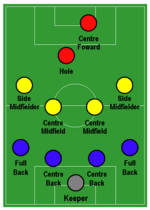
4-4-1-1 Formation
A variation of 4-4-2 with one of the strikers playing 'in the hole', or as a 'second striker', slightly behind their partner. The second striker is generally a more creative player, the playmaker.[10]
Teams that used this formation
- Italy, 2006 FIFA World Cup Winners:
- Greece, European champion 2004
- Finnish national team
- Juventus during 2001/2002 and 2002/2003 (Alessandro Del Piero as a 'trequartista' or attacking playmaker behind David Trézéguet) — this was a hugely successful strategy for Juve, as they won the Scudetto in 2002 and 2003 and finished runners-up to AC Milan in the 2003 European Champions League.
- Manchester United F.C. during 2006-07 season, In which they won the premiership for the first time in 4 years with Wayne Rooney behind Louis Saha/Ole Gunnar Solskjær/Alan Smith and Ryan Giggs on the left with Cristiano Ronaldo on the right and in the 07-08 season with Wayne Rooney up top and Carlos Tevez behind him, with Cristiano Ronaldo on the right and Ryan Giggs/Nani on the left
- Fenerbahçe S.K. 2006/2007 season Turkish League champions, under Zico's coaching.
- Team: Volkan Demirel; Önder Turacı, Diego Lugano, Edu, Ümit Özat; Stephen Appiah/Mehmet Yozgatli, Aurelio, Deniz Barış, Tuncay Şanlı; Alex de Souza; Mateja Kezman. Coach: Zico.
|
4-3-2-1 (the 'Christmas Tree' formation)

4-3-2-1 Formation
This is another variation of the 4-4-2, commonly described as the 'Christmas Tree' formation. Another forward is brought on for a midfielder to play 'in the hole', so leaving two forwards slightly behind the most forward striker. Terry Venables first brought in this system throughout England's Euro 96 campaign. Glenn Hoddle then used this formation during his time in charge of the England national football team. Since then the formation has lost its popularity in England.
Teams that used this formation
- AC Milan, 2007 Champion's League Winners:
- FC Barcelona during the 2004–05 and 2005–06 seasons when not playing 4-3-3 with Ronaldinho and Ludovic Giuly (or sometimes Lionel Messi during 2005–06) playing behind Samuel Eto'o.
- Fenerbahce during 2007/2008 season in Turkish "Süper" League and UEFA Champions League under Zico's coaching by using Deivid and Alex de Souza freely as creative forwards behind the lone striker played by Kezman and Semih in rotation.
- Team: Volkan Demirel; Gökhan Gönül, Diego Lugano, Edu, Roberto Carlos/Wederson; Aurelio, Deniz Barış, Uğur Boral; Alex de Souza, Deivid; Mateja Kezman/Semih Şentürk. Coach: Zico.
- Egypt national football team during 1998 African Cup of Nations with the coach Mahmoud El-Goharyand the pharaohs won the title.
- France national football team champions of 1998 FIFA World Cup (at the final part of the tourney):
- Manchester United FC used a formation rather resembling this for a few matches at the start of the 2008/2009 season, with Carlos Tevez and Wayne Rooney playing just behind Dimitar Berbatov. Now, however, Tevez has been benched as United play their usual 4-4-2.
|
5-3-2

5-3-2 Formation
This formation has three central defenders (possibly with one acting as a sweeper.) This system is heavily reliant on the wing-backs providing width for the team. The two wide full-backs act as wing-backs. It is their job to work their flank along the full length of the pitch, supporting both the defence and the attack.[11]
Teams that used this formation
- Germany adopted this formation between 1990 and 1994, winning the 1990 World Cup
- 1990 World Champions:
- Celtic FC under Martin O'Neill employed this formation during their 2001 treble winning season and run to the UEFA Cup Final in 2003.
|
5-3-2 with Sweeper or 1-4-3-2
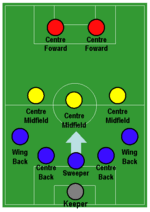
5-3-2 Sweeper Formation
A variant of the above, this involves a more withdrawn sweeper, who may join the midfield, and more advanced full-backs.
Teams used this formation:
|
3-4-3

3-4-3 Formation
Using a 3-4-3 the midfielders expected to split their time between attacking and defending. Having only three dedicated defenders means that if the opposing team breaks through the midfield, they will have a greater chance to score than with a more conventional defensive configuration, such as 4-5-1 or 4-4-2. However, the three forwards allow for a greater concentration on offense. This formation is used by more offensive-minded teams.
Teams that used this formation
- FC Barcelona during the early 1990s, with Johan Cruijff as coach (four La Liga titles in 1991, 1992, 1993 and 1994, and a Champions League in 1992)
- AC Milan during the end of the 1990s, with Alberto Zaccheroni as coach (one scudetto in 1999)
- FC Barcelona during the a portion of the 2006-2007 La Liga season. This formation was a result of Frank Rijkaard's insistence on playing Deco, Andres Iniesta, Xavi and a defensive midfielder as well. With this formation, he most commonly utilized Ronaldinho, Lionel Messi and Samuel Eto'o as forwards.
- AFC Ajax won the Champions League in 1995 when Louis van Gaal was manager. Ajax also won the Eredivisie three times - 1994, 1995 and 1996. The first eleven was: Edwin Van der Sar, Michael Reiziger, Danny Blind, Frank de Boer, Frank Rijkaard, Edgar Davids, Clarence Seedorf, Jari Litmanen, Marc Overmars, Finidi George, Patrick Kluivert.
|
3-5-2

3-5-2 Formation
This formation is similar to 5-3-2 except that the two wingmen are oriented more towards the attack. Because of this, the central midfielder tends to remain further back in order to help prevent counter-attacks. It differs from the classical 3-5-2 of the WW by having a non-staggered midfield. It was used for the first time at international level by the Argentinian coach Carlos Salvador Bilardo[12]. Many teams also use a central attacking midfielder and two defensive midfielders, so the midfielders form a W formation.
Teams that used this formation
- Beşiktaş Jimnastik Kulübü, winner of the Turkish Premer League 2002-2003;
- Team: Oscar Cordoba; Antonio Carlos Zago, Ronaldo Guiaro, Ahmet yildirim; Federico Giunti, Daniel Pancu, Kaan Dobra, Ibrahim Uzulmez, Sergen Yalçın; Ilhan Mansiz, Pascal Nouma. Coach: Mircea Lucescu.
- Argentina, 1986 World Cup winner.
- Brazil, 2002 World Cup winner:
- Glasgow Celtic, competed in the 2003 UEFA Cup Final under Martin O'Neill mostly using this formation.
- Croatia, 1998 World Cup 3rd place under Miroslav Blazevic.
- CSKA Moscow winner of the UEFA Cup 2005 (managed by Valery Gazzaev)
- Russia
- São Paulo Futebol Clube, 2005 FIFA Club World Championship winner:
- Team: Rogério Ceni; Fabão, Diego Lugano, Edcarlos; Mineiro, Josué, Cicinho, Júnior, Danilo; Amoroso, Aloísio. Coach: Paulo Autuori.
- D.C. United, 2004 MLS Cup winner, used this formation under coach Piotr Novak from 2004 - 2006
- Iran, 3 times Asian Cup Champions, coach Frank O'Farrell had used this formation in all three tournaments in which he won the cup.
|
3-6-1

3-6-1 Formation
This uncommon but modern formation obviously focuses in the ball possession in the midfield. In fact, it is very rare to see it as an initial formation, as it is better used to keep results. Its more common variants are 3-4-2-1 or 3-4-3 Diamond, which use two wingbacks. The lone forward must be tactically gifted, because he is not only focused in scoring, but to play back to the goal to assist with back passes to his teammates. Once the team is leading the game, the tactics focuses even more in ball control, short passes and time wasting. On the other hand, when the team is losing, at least one of the playmakers will play more often in the edge of the area to add depth to the attack. Guus Hiddink is one of the few coaches who has used this formation when coaching Australia, in the 2006 World Cup
Teams that used this formation
- South Korea, 2002 FIFA World Cup fourth place, with Lee Woon-Jae, Choi Jin-Cheul, Hong Myung Bo, Kim Tae-Young, Song Chong-Gug, Lee Young-Pyo, Kim Nam-Il, Yoo Sang-Chul, Park Ji-Sung, Seol Ki-Hyeon, Ahn Jung Hwan Coach: Guus Hiddink.
- Australia, 2006 FIFA World Cup second round.
- United States, 1998 FIFA World Cup.
|
4-5-1

4-5-1 Formation
4-5-1 is a defensive formation; however if the two midfield wingers play a more attacking role it can be likened to 4-3-3. The formation can be used to grind out 0-0 draws or preserve a lead, as the packing of the centre midfield makes it difficult for the opposition to build-up play. Because of the 'closeness' of the midfield, the opposing team's forwards will often be starved of possession. However, due to the lone striker, the centre of the midfield does have the responsibility of pushing forward as well. The defensive midfielder will often control the pace of the game.[13]
Teams that used this formation
- Norwegian national team with great success in the early/mid-90s.
- Liverpool FC, 2005 UEFA Champions League winner
- Arsenal FC, frequently during the 2005-2006 season with Cesc Fabregas as a playmaker and Thierry Henry as the lone striker
- Olympique Lyonnais, Ligue 1 Winners 2001/02 2002/03 2003/04 2004/05 2005/06
- Rangers often used this formation while getting to the 2008 Uefa Cup Final under Walter Smith with Brahim Hemdani in the holding role and typically Jean-Claude Darcheville as the lone striker.
- Hamilton Academical, Scottish First Division Winners 2007/2008 successfully used this formation all season with Richard Offiong spearheading the attack, netting 19 league goals in the process.
|
4-2-3-1
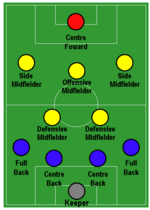
4-2-3-1 Formation
This formation is widely used by Spanish and French sides: it is a defensive formation which is quite flexible, as both the side midfielders and the fullbacks may join the attack, usually on the counter. In defense, this formation is similar to the 4-5-1. It is used to maintain possession of the ball and stopping opponent attacks by controlling the midfield area of the field. The lone striker may be very tall and strong to hold the ball up as his midfielders and fullbacks join him in attack. The striker could also be very fast. In these cases, the opponent's defense will be forced to fall back early, thereby leaving space for the offensive central midfielder. This formation is used especially when a playmaker is to be highlighted.
This formation is also currently used by Brazil as an alternative to the 4-2-4 formation of late 50's to 1970. Implemented similarly to how original 4-2-4 was used back then, use of this formation in this manner is very offensive, creating a 6-man attack and a 6-man defense tactical layout. The front 4 attackers are composed as wide forwards and playmaker forward in support of a target striker in front.
Teams that used this formation
- France used this formation in the Euro 2000 final win against Italy (with Patrick Vieira and Didier Deschamps as the defensive midfielders' and Thierry Henry as the lone striker).
- Brøndby I.F., SAS Liga runners up 2002/03, 2003/04 and 2005/06 and winners 2004/05 (with either Thomas Kahlenberg or Johan Elmander as a playmaker).
- AS Roma, Serie A 2005-06, 2006-07 and in the current 2007-08 season (4th, 2nd and 2nd).
- Team: Doni; Christian Panucci/Marco Cassetti/; Philippe Mexès, Cristian Chivu/Juan (from the 2007-08 season), Max Tonetto; Daniele De Rossi, David Pizarro/Alberto Aquilani; Rodrigo Taddei, Simone Perrotta, Amantino Mancini; Francesco Totti/Mirko Vucinic.
- Grêmio FBPA, Campeonato Brasileiro 2006 3rd
- Team: Galatto; Alessandro, William, Teco, Patrício; Jeovânio, Lucas; Hugo, Tcheco, Rômulo; Herrera. Coach: Mano Menezes.
- France, 2006 FIFA World Cup Runners-Up:
- Portugal, 2006 FIFA World Cup 4th
- Real Madrid C.F. 2006/2007 La Liga Winners
- Liverpool F.C., began using this formation in the 2007/08 season.
- River Plate used this as a main formation under Simeone for the 2008 Clausura. River won the tournament
- The Netherlands uses this formation for the Euro 2008.
Or: Edwin Van der Sar; Khalid Boulahrouz, André Ooijer, Joris Mathijsen, Giovanni van Bronckhorst; Nigel de Jong, Rafael Van der Vaart; Dirk Kuyt / Robin van Persie, Wesley Sneijder, Arjen Robben; Ruud Van Nistelrooy. (But this is very similar to 4-3-3, because Van der Vaart is not a typical defensive midfielder.) Coach: Marco Van Basten.
- The Germany used this formation in the Euro 2008 quarter-final, semi-final and final.
- Australia have employed this formation under the tenure of Pim Verbeek, during the third round of the AFC 2010 World Cup Qualifiers. Interestingly, erstwhile left-winger Harry Kewell has been employed as a lone striker. It is likely that both the formation and choice of players was decided as much by player availability as any other conideration.
Teams that used this formation as a variation of attacking 4-2-4
- Brazil using Ronaldinho, Kaka, Robinho as creative forwards behind and around Vagner Love or Luis Fabiano in recent 2010 World Cup qualification games.
|
4-6-0
A highly unconventional formation, the 4-6-0 is an evolution of the 4-2-3-1 in which the centre forward is exchanged for a player who normally plays as a trequartista (that is, in the 'hole'). Suggested as a possible formation for the future of football,[14] the formation sacrifices an out-and-out striker for the tactical advantage of a mobile front four attacking from a position that the opposition defenders cannot mark without being pulled out of position.[15] However, owing to the intelligence and pace required by the front four attackers to create and attack any space left by the opposition defenders, the formation requires a very skilful and well-drilled front four. Due to these high requirements from the attackers, and the novelty of playing without a proper goalscorer, the formation has been adopted by very few teams, and rarely consistently. The formation was first professionally adopted by Luciano Spalletti's Roma side during the 2005-06 Serie A season (mostly out of necessity) as his "strikerless formation",[16] and then notably by Alex Ferguson's Manchester United side in the 2007-08 Premier League season (who won the Premier League and Champions League that season).[17]
5-4-1
This is a particularly defensive formation, with an isolated forward and a packed defense. Again however, a couple of attacking fullbacks can make this formation resemble something like a 3-4-3.
Incomplete formations
When a player is sent-off (after being shown a red card), the teams generally fall back to defensive formations such as 4-4-1 or 5-3-1. Only when a draw is not an option (e.g. in a playoff or knockout match) will a team with ten players play in a risky attacking formation such as 4-3-2 or even 4-2-3. When more than one player is missing from the team the common formations are generally disbanded in favour of either maximum concentration on defense, or maximum concentration on attack.
Future formations
The thinking about the future of football formations is that, with the increase in fitness of players, the normal, symmetrical formation is out of date. Variety is needed in teams; so a pacey, direct winger might be deployed with a slower, more creative player on the other flank. An example can be seen with the Argentina national team playing "one armed" with Juan Riquelme attacking from the left, or the Manchester United F.C. team of the 1990s with Ryan Giggs making attacking runs from one wing with David Beckham playing crosses from deeper on the other. This is now evident again in the Manchester United squad as Cristiano Ronaldo makes attacking runs and Ryan Giggs provides the crosses.
See also
- Football (soccer) tactics and skills
- Catenaccio
- Total Football
References
External links
|
